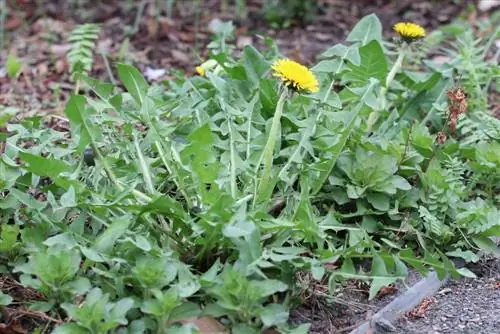- Author admin [email protected].
- Public 2023-12-17 03:39.
- Last modified 2025-06-01 06:48.
All runner-growing bamboos with leptomorphic rhizomes, especially all Phyllostachys, should only be planted with a rhizome barrier. In other words, planting may only be done with a rhizome barrier; in terms of liability law, you are obliged to install a rhizome barrier for bamboo plants that sprout runners. But there are more humble bamboos:
Not every bamboo wants world domination
As is often the case with plants - not all bamboos are the same: There are bamboos whose rhizomes grow so deep into the earth that the often sold 70 cm rhizome barrier does not form an obstacle and the bamboo with the help of its underground rhizomes Easily conquers up to 10 meters of garden underground in one growing season. If you are reading this article, if such a bamboo is still quite small but is growing in the garden without a (sufficiently deep) rhizome barrier, you should run to the spade to start the - which takes a long time - digging. You can continue to watch other bamboos grow in complete peace, because in the worst case scenario you have to dig out a really thick root, but it largely remains in its place. Bamboos develop two very different growth forms of rhizomes that grow underground, which also determine whether and how much a bamboo spreads: Dangerous leptomorphic rhizomes and harmless pachymorphic rhizomes.
Bamboo, botanically called Marmoroideae, is one of the twelve subfamilies into which the sweet grass family is divided. This subfamily is divided into three tribes:
- Arundinarieae, 28 genera, 533 species, woody grasses of the temperate zone
- Bambuseae, 66 genera, 784 species, woody grasses of the tropics and subtropics
- Olyreae, 21 genera, 122 species, non-woody (herbaceous) grasses from the southern part of the American continent
Makes 115 genera with 1439 species of bamboo, and from each genus bamboos are cultivated for ornamental purposes, which requires an overview. The bamboo genera are therefore classified below according to the growth form of the rhizome. You can search for your bamboo in the alphabetical list (of the “nice”, “not so bad” and “bad”) bamboos and then read the tips on how to remove and permanently destroy its rhizomes:
The Nice Bamboo
belongs to the tribe Bäumeae, in which the following genera can be found:
- Actinocladum
- Alvimia
- Apoclada
- Arthrostylidium
- Athroostachys
- Atractantha
- Aulonemia
- Bambusa
- Bonia
- Cathariostachys
- Cephalostachyum
- Chusquea
- Colanthelia
- Cyrtochloa
- Davidsea
- Decaryochloa
- Dendrocalamus
- Dendrochloa
- Didymogonyx
- Dinochloa
- Elytrostachys
- Eremocaulon
- Filgueirasia
- Fimbribambusa
- Gigantochloa
- Glaziophyton
- Greslania
- Guadua
- Hickelia
- Hitchcockella
- Holttumochloa
- Kinabaluchloa
- Maclurochlora
- Melocalamus
- Melocanna
- Merostachys
- Mullerochloa
- Nastus
- Neohouzeaua
- Neololeba
- Neomicrocalamus
- Ochlandra
- Olmeca
- Oreobambos
- Otatea
- Oxytenanthera
- Parabambusa
- Perrier bamboo
- Phuphanochloa
- Pinga
- Pseudobambusa
- Pseudostachyum
- Pseudoxytenanthera
- Racemobambos
- Rhipidocladum
- Schizostachyum
- Sirochloa
- Soejatmia
- Spherobambos
- Stapletonia
- Teinostachyum
- Temochloa
- Temburongia
- Thyrsostachys
- Valiha
If your bamboo was included, you can sit back and relax when it comes to rhizomes and their removal. These bamboos form pachymorphic rhizomes, with a short or long rhizome neck depending on the variety. The rhizome bodies of pachymorphic rhizomes are always thick and short, which is why these species form coherent clumps (and not extensive underground networks). The shorter the rhizome neck, the more compact the clump of stalks. However, you never lose control over a bamboo with a pachymorphic rhizome; in the worst case (with very old plants), species with a very long rhizome neck will have a major digging problem.
However, it is not very likely that you will have to do such digging to remove the rhizome: If you were given a bamboo from the list above and it is now in the garden (because you and the gift giver were told that because it is hardy), the relaxation is over again. These bamboo species come from the tropics and subtropics of the New and Old Worlds and are not hardy here. Exceptions are cultivated varieties of Bäume: Marmora multiplex 'Elegans' is said to withstand temperatures down to -9 °C, 'Alphonse Karr' even more than -11 °C. Marmoreae are hepaxanthic=the plants die after the only flowering period of their life, entire groups of a species always bloom at the same time. Your seller should be able to tell you when the bamboo species last bloomed and at what intervals the blooms occur, based on experience.
The not-so-bad bamboo
belongs to the tribe Olyreae, which includes these genera:
- Agnesia
- Arberella
- Buergersiochloa
- Cryptochloa
- Diandrolyra
- Ekmanochloa
- Heremitis
- Froesiochloa
- Lithachne
- Maclurolyra
- Mniochloa
- Olyra
- Pariana
- Parodiolyra
- Piresia
- Piresiella
- Raddia
- Raddiella
- Rehia
- Reitzia
- Sucrea
The Olyreae are more closely related to the Bäumeae than to the Arundinarieae; they form weakly to clearly developed, leptomorphic rhizomes, the potential of which you will soon get to know. However, the Olyreae are more harmless in that they are native to South America and the Caribbean and can only be kept in pots here. There the Olyreae are welcome to stretch their rhizomes towards the wall of the container; Olyreae grow as soft (herbaceous) grasses and not as woody giant grasses. In the Olyreae, only a few species are hapaxanthic (dying after flowering), which could mean that multiple flowering bamboos are hidden among them. Since bamboos not only bloom at very long intervals, but also at irregular intervals, unfortunately nothing is known yet.
The bamboos that are really hardy here unfortunately come from a different tribe:
Caution: Evil Bamboo
Almost all members of the genera of the tribe Arundinarieae listed below can make garden life difficult for you without a rhizome barrier, and some can make it very difficult very quickly:
- Acidosasa
- Ampelocalamus
- Arundinaria
- Bashania
- Mountain Bamboos: Newly discovered African genus
- Chimonobambusa
- Chimonocalamus
- Drepanostachyum
- Fargesia: Forms pachymorphic rhizomes that are not typical of Arundinarieae and grows in clumps, many Fargesia species are hardy down to over -20 °C and are therefore widespread
- Ferrocalamus
- Gaoligongshania
- Gelidocalamus
- Himalayan calamus
- Indocalamus
- Indosasa
- Kuruna: Newly discovered genus in Sri Lanka, bamboo used to temperate climates with pachymorphic, short-necked rhizome
- Oldeania: Newly discovered African genus
- Oligostachyum
- ×Phyllosasa
- Phyllostachys: Popular with us because of its good winter hardiness, but extremely dangerous because of its sometimes endless rhizomes
- Pleioblastus
- Pseudosasa
- Sarocalamus
- Sasa
- Semiarundinaria
- Shibataea
- Sinobambusa
- Thamnocalamus
- Vietnamocalamus
- Yushania
The bamboos of the tribe Arundinarieae usually form leptomorphic rhizomes with well-developed stalk bases. Leptomorphic rhizomes develop long, thin rhizome bodies, often smaller in diameter than the stems that form, and short rhizome necks. The leptomorphic rhizomes sprout runners that branch almost infinitely underground, ever further and again, up to a few meters per season. In addition, Arundinarieae bloom and then die at intervals of 2 to 200 years - often all representatives or large groups of a species together and at the same time.
The Nerds
do not adhere to the specification of pachymorphic or leptomorphic rhizomes, but have their own ideas, e.g. B. the amphipodial growth. These are growth forms with leptomorphic rhizomes in which the buds of the stalk bases form further stalks. This leads to tillering and a clump-like distribution of the stalks. The culm bases resemble pachymorphic rhizomes, but are not thicker than the culms. This growth form occurs in the genera:
- Arundinaria
- Indocalamus
- Pseudosasa, Pseudosasa brevivaginata
- Shibataea
- Sasa
- Yushania
up.
There are also bamboo species that form leptomorphic and pachymorphic rhizomes on a plant, for example:B. some species of the genus Chusquea. They form pachymorphic rhizomes on the lateral buds of leptomorphic rhizomes, which then branch further and at the end of which the stalks form. How “dangerous” the rhizomes can become must be explored for each species.
Individual bamboo species with their own variants of rhizome growth
- Bambusa vulgaris: Pachymorphic rhizomes with longer necks, less compact, spreading clumps
- Chusquea fendleri: Forms dense tufts of stalks through tillering and at the same time leptomorphic and pachymorphic rhizomes
- Dendrocalamus membranaceus: Short-necked, pachymorphic rhizomes, separate, very compact clumps
- Fargesia nitida: Pachymorphic rhizomes with longer necks, less compact clumps
- Melocanna baccifera: long-necked, pachymorphic rhizome, open growth with distributed stalks
- Phyllostachys edulis: Leptomorphic rhizome with open growth, distributed stalks
- Semiarundinaria fastuosa: Through tillering, it forms dense tufts of stalks, long-necked pachymorphic rhizomes
- Shibataea kumasasa: Small butcher's broom bamboo, dense tufts of stalks, tillering, long-necked pachymorphic rhizomes
- Yushania niitakayamensis: Amphipodial growth with connected leptomorphic rhizomes, but interesting ground-cover dwarfism with fairly good winter hardiness
Subsequent installation of a rhizome barrier
Whenever leptomorphic rhizomes are involved in a bamboo, if this bamboo is in a garden without a rhizome barrier and can survive in our gardens, there is a need for action. Here are your options:
- Subsequent installation of rhizome barrier
- Possible, but labor intensive
- Dig a narrow trench around the planting area
- Mini excavator, trencher, hardened drainage spade and pickaxe make the work easier
- Sink the rhizome barrier and let it protrude by around 10 cm
- Fill the trench and compact the soil well
- Cut/saw off all stalks outside the barrier directly on the ground
- You will have to repeat this for about three years now
- With decreasing intensity, at some point all rhizomes are dead because they cannot survive without leaves
Remove bamboo with leptomorphic rhizomes, permanently destroy rhizomes
Also possible, but much more labor-intensive:
- Destroy as much bamboo as possible above the ground: wait for new growth and cut off all stalks close to the ground
- Bamboo + rhizome must be dug up, as completely as possible
- On an already well-spread bamboo, only the excavator will work completely
- You could get help by offering the bamboo to a network of interested gardeners
- Then at least a lot of people are digging and not just you
If you don't get all the rhizomes during the destruction campaign, more or less rework will be necessary at some point. If a few scattered stalks appear, you can try to weaken the bamboo more and more by immediately cutting or mowing down any new growth close to the ground. Done consistently, this will eventually kill the rhizomes in the soil because they are nourished by photosynthesis from the stalks above the soil. It is not necessarily advisable to continue digging: one of the most widespread and annoying bamboos, Phyllostachys, sends its runners radiating in all directions, and every remaining piece of root over 5 cm long continues to sprout. So if you just dig somewhere where a stalk comes up, you would just make the underground root network ever denser. Perhaps it would be better, starting from the original bamboo, to understand where the rhizome comes from and, after cutting it with a spade cut in that direction, to pack it in a thick piece of black tubing, well wrapped with several layers of foil. You can then follow the “rhizome cable” in the opposite direction and dig it out.
If you want to use weed killers (which is not recommended here because of the increasing media reports about he alth damage caused by the active ingredients), make sure that you need a weed killer against monocotyledonous weeds. If you use a "normal" weed killer against dicotyledonous weeds, it won't do anything to the bamboo, but will only kill nearby flowers and bushes - the weed killer against monocotyledonous weeds will "only" kill your lawn apart from bamboo.
Conclusion
Bamboo with leptomorphic rhizomes must either be destroyed or subsequently limited by blocking the rhizomes and removing the shoots that grow outside if it is not to send a stalk through the living room floor at some point. Some work, but take comfort in the fact that there are also people who have seeded a sequoia tree in their garden - it doesn't send roots through the floor, it just tips over the house.






